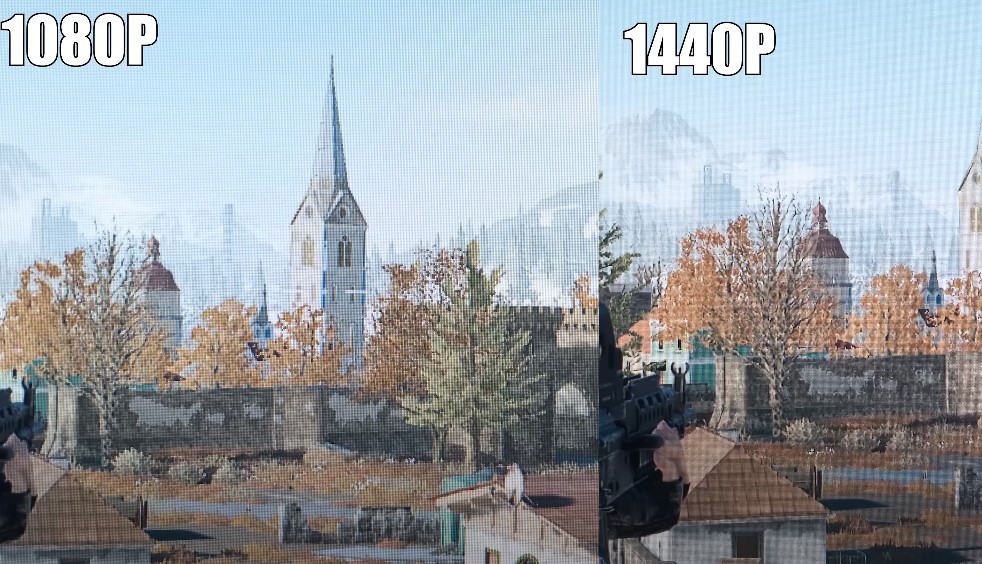As an enthusiast exploring the world of monitors, the choice between 1080p and 4k is a critical one that impacts both the viewing experience and the performance demands on one’s system.
Resolution is a key factor that defines the sharpness and detail of the displayed content, with 1080p also known as Full HD, offering a resolution of 1920×1080 pixels.
On the other hand, 4k, or Ultra HD, packs in significantly more pixels with a resolution of 3840×2160, promising incredibly lifelike visuals that can enhance both work and play.
Choosing between these two options goes beyond just counting pixels. A 4k monitor provides a higher pixel density which can translate to crisper text, more detailed images, and a greater workspace on the screen.
However, this leap in resolution also comes with a set of considerations such as the need for more powerful hardware to drive the higher pixel count, especially for gaming or high-resolution video editing.
Meanwhile, 1080p monitors are more affordable and less demanding on hardware, making them a go-to choice for gamers who prioritize high refresh rates and lower response times for a smooth gaming experience.
Key Takeaways
- 1080p (Full HD) offers 1920×1080 pixels ideal for general use and gaming, while 4K (Ultra HD) with 3840×2160 pixels excels in detailed visuals and professional tasks.
- 4K monitors require more powerful hardware for optimal performance, particularly in gaming and high-resolution video editing, compared to the less demanding 1080p monitors.
- 1080p monitors are more affordable and offer good value for everyday use and gaming, whereas 4K monitors, though pricier, provide superior image quality and detail.
- Different panel types (IPS, VA, OLED) and specifications like refresh rate and response time significantly affect the viewing experience and performance of the monitor.
- Investing in 4K monitors can be a future-proof choice, anticipating the shift to higher resolutions like 8K, while considering the importance of scaling capabilities.
- The choice between 1080p and 4K affects ergonomics and multi-monitor setups, with optimal viewing distances and screen real estate varying based on resolution and individual usage requirements.
Overview of Monitor Resolution
When discussing monitor resolution, crucial aspects to understand are the number of pixels on the screen, which directly impacts the clarity and detail of the image as noted by Lenovo website. The more pixels a monitor has, the higher the resolution, and consequently, the sharper the image.
Resolution Basics
Monitor resolution refers to the number of distinct pixels that can be displayed in each dimension. It’s typically represented by the width and height of the pixel array. For instance, a 1080p resolution, also known as Full HD (FHD), has a pixel count of 1920 by 1080. In this context, FHD resolution provides a solid baseline for clarity and detail, suitable for general use such as watching videos or everyday tasks.
Comparing: 1080p, 1440p, and 4k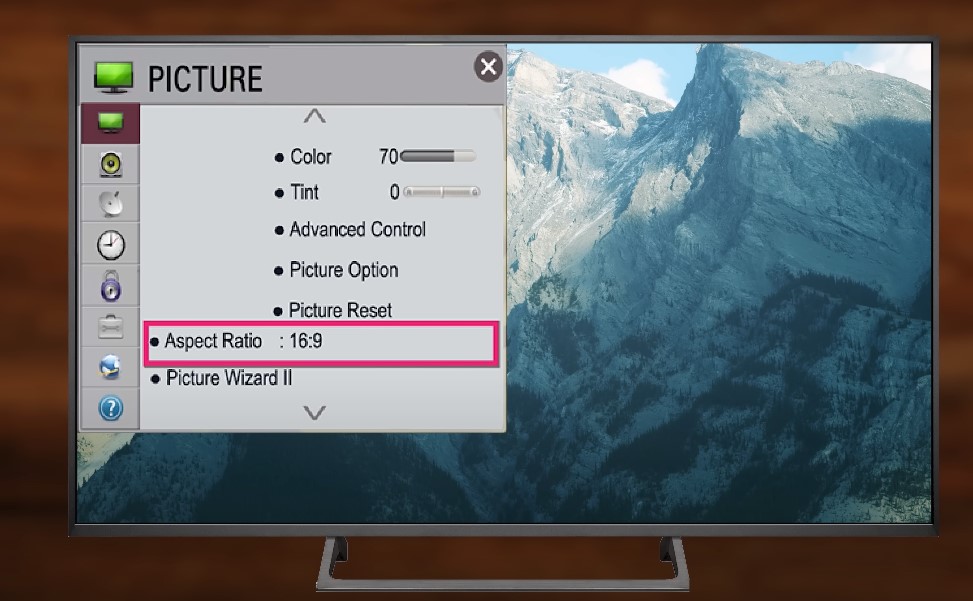
1080p (FHD – Full HD): 1920 x 1080 pixels
- Commonly used in TVs and standard computer monitors.
- Delivers good image quality for most content.
1440p (QHD – Quad HD): 2560 x 1440 pixels
- A step up from FHD, offering more detail, beneficial for gaming and professional work.
- Strikes a balance between performance and graphics fidelity.
4k (UHD – Ultra HD): 3840 x 2160 pixels
- Contains four times the pixels of 1080p, providing significantly sharper images.
- Ideal for high-end gaming, professional graphic design, and viewing 4K content.
Translating these resolutions to experience, as a user, I notice that text is crisper and images more detailed as I move from FHD to QHD, and then to UHD. While all contribute to a more immersive viewing, it’s 4K resolution that meets my needs for precision and visual clarity in high-end tasks.
1080p Monitors
In my experience, 1080p monitors, also known as Full HD displays, offer a good balance between performance and cost. They are capable of displaying a resolution of 1920×1080 pixels, which still remains the standard for a wide range of uses.
Advantages of 1080p
- Performance: A key advantage of 1080p monitors is that they require less graphic processing power, making them compatible with a wide array of computers according to Reolink. This means smoother performance, particularly when it comes to maintaining high frame rates without requiring expensive graphics cards.
- Cost: 1080p monitors generally come with a more affordable price tag compared to their 4K counterparts. For users who need to be cost-conscious, these monitors provide a solid, high-definition experience without breaking the bank.
Common Uses

- Home and Office Work: For tasks like web browsing, office applications, and video streaming, 1080p monitors offer clear and sharp images.
- Professional Use: In environments where color accuracy and line sharpness are crucial, such as graphic design or photo editing, Full HD monitors can provide ample resolution.
Gaming
Refresh Rate
1080p gaming monitors can offer very high refresh rates — sometimes up to 144Hz or more, which is a boon for competitive gaming where every millisecond counts.
Adaptive Sync Technology
Many 1080p gaming monitors include adaptive sync technologies like FreeSync or G-Sync according to PC World. These features synchronize the refresh rate of the monitor with the frame rate of the graphics card to eliminate screen tearing and stuttering for a smoother gaming experience.
4k Monitors
When I refer to 4k monitors, I’m discussing the pinnacle of resolution available for consumer displays. These monitors offer unparalleled detail and image quality for various applications.
Advantages of 4k Monitors
4k monitors, also known as Ultra HD monitors, boast a resolution of 3840 x 2160 pixels, which is four times the pixel count of Full HD (1080p) displays. This higher pixel density results in sharper and more detailed images, making them ideal for content creation and professional applications where precision is critical as highlighted by Gumlet.
With an IPS panel, 4k monitors often provide wide viewing angles and superior color reproduction. High Dynamic Range (HDR) compatibility in many 4k monitors enhances the color depth and contrast, providing a more vibrant and lifelike viewing experience.
When to Choose
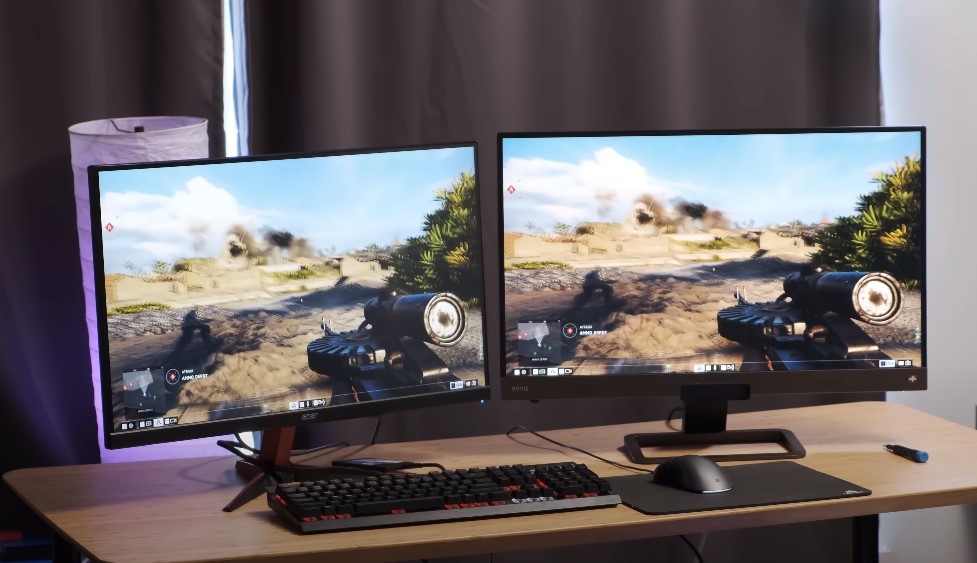 I recommend choosing a 4k monitor when your primary concerns are detail and image quality, especially if you’re engaged in professional photo and video editing. The increased resolution of 4k content is noticeable if you have a larger screen or if you sit close enough to appreciate the improved pixel density.
I recommend choosing a 4k monitor when your primary concerns are detail and image quality, especially if you’re engaged in professional photo and video editing. The increased resolution of 4k content is noticeable if you have a larger screen or if you sit close enough to appreciate the improved pixel density.
However, keep in mind that the benefits of 4k become more pronounced on screens larger than 27 inches, as this is the point where you’ll start to notice the improved resolution compared to 1080p.
4k in Gaming and Professional Use
For gaming, 4k brings an intense level of detail to the experience, assuming you have a potent graphics card capable of handling the high resolution and larger monitors. It’s critical to ensure your GPU can run games at 4k without compromising performance according to PC Magazine.
In professional contexts, such as graphic design or 3D modeling, the precision and clarity offered by 4k monitors can significantly enhance productivity.
They allow for more screen real estate and sharper visuals, which are critical for detailed work. Users must also consider the types of 4k content they’ll be viewing or editing, as not all media is created in 4k resolution yet, though it’s steadily becoming more common.
Comparing Technologies
When assessing monitor technologies, it’s crucial to understand the different panel types, how refresh rates and response times affect performance, and the influence of pixel density on image clarity. These factors collectively determine the visual experience provided by either 1080p or 4k monitors.
IPS vs VA vs OLED Panels
IPS (In-plane switching) Panels
I offer excellent color reproduction and wider viewing angles. You’ll find that IPS monitors excel in color accuracy, making them ideal for tasks where color fidelity is important. They also typically have a consistent level of brightness and avoid color shift when viewed at different angles.
VA (Vertical Alignment) Panels
This type of panel is often favored for its superior ability to represent darkness, which enhances the viewing experience in environments with lower ambient light.
OLED (Organic Light-Emitting Diode) Panels
These panels often surpass IPS and VA in terms of contrast and are extremely responsive, though they may come at a higher cost and carry the risk of burn-in over time.
What is Refresh Rate and Response Time
Refresh Rate
As advocate for smooth imagery, I recognize the importance of refresh rates. The higher the refresh rate, typically measured in Hertz (Hz), the smoother the motion appears.
While a 60Hz refresh rate is standard for most tasks, gaming or high-action video content benefits vastly from monitors with a 120Hz or higher refresh rate to avoid motion blur as noted by BestBuy.
Response Times
I can’t overlook response times, which are crucial for fast-paced activities. Response time refers to how quickly a pixel can change from black to white (or from one shade of gray to another), typically measured in milliseconds (ms). Lower response times mean less motion blur and ghosting, contributing significantly to overall image quality.
Pixel Density and Image Clarity
- Pixel Density: This refers to the number of pixels present in a given area of the screen, typically per inch (PPI). Higher pixel density on my monitor means finer detail and improved clarity as referred by TechTarget. I appreciate that 4k monitors excel in this regard, offering a significant increase in pixel density over 1080p, which tends to lead to sharper images, especially noticeable in larger monitor sizes.
- Image Clarity: With regards to clarity and detail, I understand that it’s not just about resolution. The panel type and the quality of the RGB color production also play a pivotal role. Naturally, 4k monitors can display more detail due to their higher resolution, but the panel type can affect the crispness and vibrancy of the image produced.
Upgrade Considerations
When contemplating a switch from a 1080p to a 4K monitor, I consider three main factors: whether it’s the right time to upgrade, the hardware required to power a 4K display, and the balance between cost and the performance gains I can expect.
Is It Time to Upgrade?
I evaluate my current monitor’s performance and needs. If I’m frequently engaging with high-definition content or professional graphics work, the crisp resolution of a 4K monitor could significantly impact my viewing and editing experience. However, if my activities are mostly web browsing and office applications, it might not warrant the change just yet.
Hardware Requirements for 4k
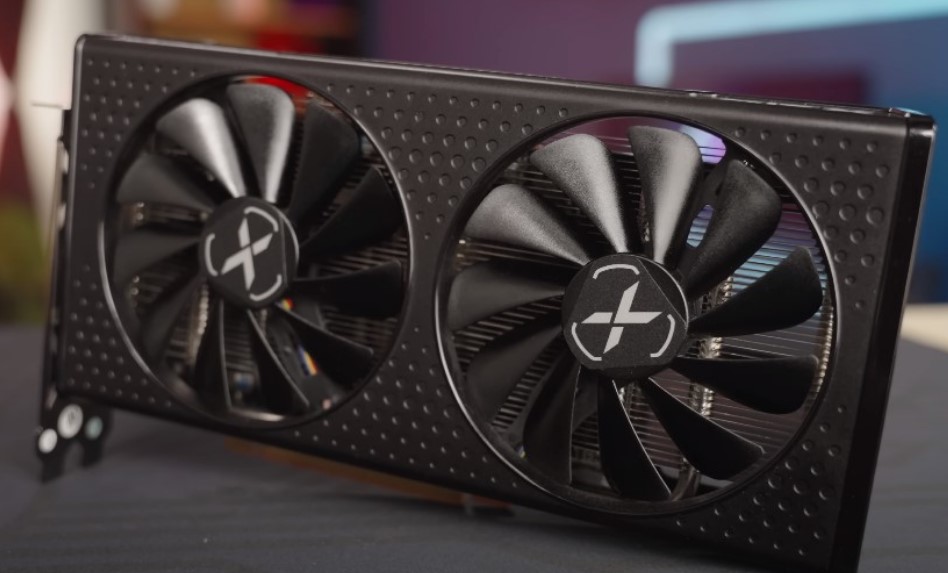
Upgrading to a 4K monitor necessitates a capable graphics card (GPU). You need a GPU with enough power to handle the 4K resolution, which means a significant bump from what’s needed for 1080p according to Lenovo.
Not all GPUs are created equal; some are better suited for gaming, while others are optimized for creative tasks. Hence, I make sure my hardware matches my 4K ambitions. Below is a brief list of GPUs that support 4K:
Cost vs Performance
The cost of 4K monitors has decreased, but they are still pricier than 1080p options. When considering an upgrade, I weigh the cost against the performance enhancement I’ll receive. I ask myself:
- Will the sharper image improve my productivity or entertainment experience?
- Is the price difference justifiable for my use case?
For gaming, the consideration includes whether my current setup can achieve high frame rates at 4K without compromising performance. If not, am I ready to invest in more powerful hardware?
Visual Experience and Usage

When considering the visual experience and usability of monitors, the resolution significantly impacts how I engage with different activities. Whether it’s gaming, streaming content, or carrying out productivity tasks, the choice between 1080p and 4k can influence both the quality of visuals and the effectiveness in completing certain tasks.
Gaming Experience on Different Resolutions
In my gaming sessions, I noticed that 4k gaming offers a more detailed and immersive experience. The increased resolution means that games can display more intricate textures and finer details, enhancing realism.
However, to take full advantage of this, I ensure that my hardware is capable of running games at such high resolutions without compromising performance. On the other hand, 1080p gaming is still quite prevalent and offers a very smooth experience, especially on gaming monitors that can push higher frame rates.
Content Streaming and Production
 While streaming services are increasingly offering content in 4k, the improved sharpness and image detail are easily noticeable on a 4k monitor. For content producers, editing in 4k allows me to see the finest details, making it possible to fine-tune my edits with great precision.
While streaming services are increasingly offering content in 4k, the improved sharpness and image detail are easily noticeable on a 4k monitor. For content producers, editing in 4k allows me to see the finest details, making it possible to fine-tune my edits with great precision.
Nevertheless, 1080p still retains its relevance, especially for viewers who have limited internet bandwidth or are watching on smaller screens where the difference in resolution is less discernible.
Task-Oriented Monitor Selection
The choice between 1080p and 4k monitors also extends to productivity tasks. When working with text, spreadsheets, or other typical office applications, 4k monitors provide the advantage of sharper text and the ability to display more content on the screen without scrolling according to BenQ.
This can improve my efficiency and reduce eye strain. However, for tasks that do not benefit from the extra pixels, a good quality 1080p monitor can be more cost-effective and still deliver a satisfactory visual experience.
Future-Proofing Your Setup
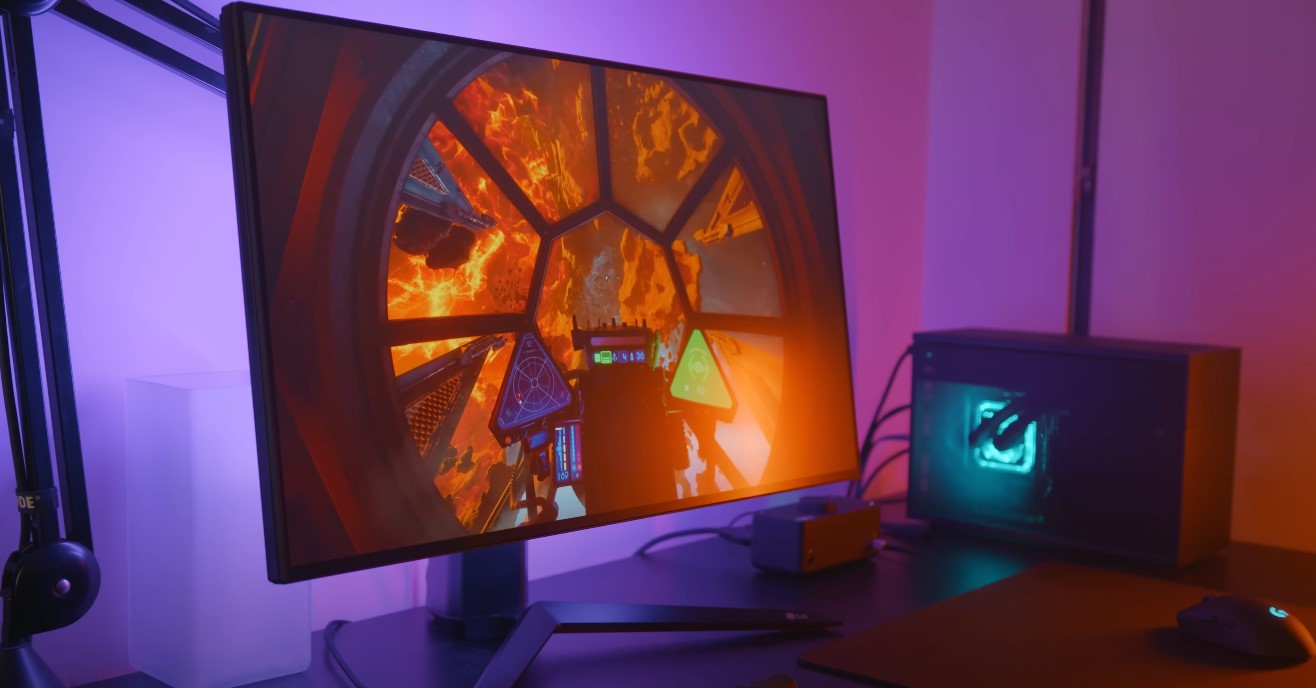 When considering future-proofing my setup, I focus on ensuring that my investment in a monitor keeps pace with evolving technology and media standards.
When considering future-proofing my setup, I focus on ensuring that my investment in a monitor keeps pace with evolving technology and media standards.
This means my choice today should accommodate the rapid advances in resolution and display technology that are just over the horizon.
Anticipating the Shift to Higher Resolutions
I’m aware that 4K is quickly becoming the standard resolution for high-end monitors, but 8K is on the not-too-distant horizon. When thinking about future-proofing, the concept of scaling becomes significant. My current hardware may need an upgrade to handle the demands of 8K content.
Choosing a monitor with a high resolution now means I’m one step ahead. This doesn’t merely apply to pixel count, but also to how the monitor handles scaling up lower-resolution content to look crisp on a high-definition display.
| Resolution | Ideal for |
|---|---|
| 1080p | Standard office work and casual use |
| 4K | Professional work, gaming, and multimedia |
| 8K | Future multimedia and high-end professional tasks |
Emerging Monitor Technologies
Beyond resolution, other advances in monitor technologies are essential for me to consider. Ultrawide displays are one example, offering more screen real estate and an immersive experience that traditional 16:9 monitors don’t.
They’re becoming popular for multitasking and gaming, and their prevalence in the market is a hint at what the standard may soon become also noted by PCWorld.
The technology in terms of terms of connectivity is also something I consider. I make sure my monitor has modern ports like HDMI 2.1 and DisplayPort 1.4 or higher to avoid compatibility issues with future devices.
Ergonomics and Multi-Monitor Setups
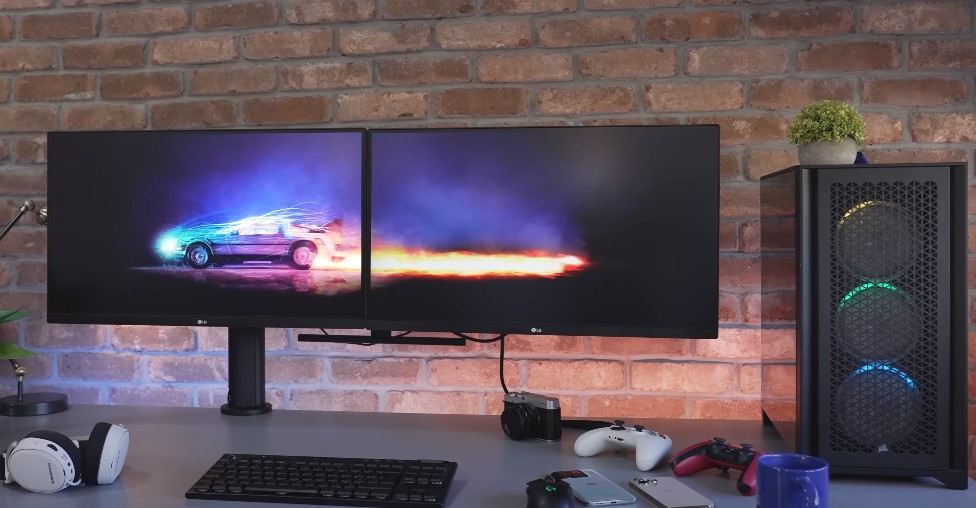 For a 1080p monitor, the ideal viewing distance is typically between 20 to 40 inches (50 to 100 cm), which allows for clear visibility without straining the eyes. When it comes to 4k monitors, I find that this distance can be slightly closer due to the higher resolution, enhancing detail at a shorter distance without causing discomfort. In a multi-monitor configuration, especially with dual monitors or an ultrawide monitor, maintaining an ergonomic setup is paramount.
For a 1080p monitor, the ideal viewing distance is typically between 20 to 40 inches (50 to 100 cm), which allows for clear visibility without straining the eyes. When it comes to 4k monitors, I find that this distance can be slightly closer due to the higher resolution, enhancing detail at a shorter distance without causing discomfort. In a multi-monitor configuration, especially with dual monitors or an ultrawide monitor, maintaining an ergonomic setup is paramount.
- 1080p monitors: Best viewed at 20-40 inches
- 4k monitors: Optimal closer than 1080p for detailed work
I ensure that the top of the screen is at or just below eye level and that the screens form a slight arc, allowing my eyes to maintain a consistent distance from the screen as they move across the display area. For dual monitors, I place them side by side with no gap and angle them to create an uninterrupted viewing area.
Benefits of Multi-Monitor Environments
Multi-monitor setups, particularly in a home office, can significantly boost productivity tasks. Having more than one screen allows me to display and reference multiple documents simultaneously, reducing the need to toggle between windows.
This is particularly useful for tasks such as coding, video editing, or any work that involves comparing and analyzing information from various sources.
- Productivity: Increases by providing multiple views
- Task Efficiency: Reduces window toggling
Dual monitors come in handy for expanding my digital workspace, while ultrawide monitors offer an expansive screen real estate on a single display. Regardless of the choice, I ensure that the screens are positioned to minimize head and eye movements, which can reduce muscle strain and increase work comfort over extended periods.
Frequently Asked Questions
What are the visual differences between a 1080p and a 4K display?
A 4K display boasts a resolution of 3840×2160 pixels, providing a significantly sharper and more detailed image than a 1080p monitor, which has a resolution of 1920×1080 pixels. This results in a clearer picture on a 4K screen, particularly noticeable in larger monitor sizes.
How does 4K resolution benefit gaming compared to 1080p?
For gaming, 4K resolution delivers more detailed and immersive visuals, making in-game textures and elements more refined. Gamers with high-performance graphics cards will benefit most from a 4K display’s enhanced resolution, assuming they can maintain a high frame rate for smooth gameplay.
When considering monitors for professional work, is 4K a better choice than 1080p?
Professionals who require accurate detail and more on-screen real estate, such as graphic designers or video editors, will find a 4K monitor to be a better choice. The extra pixels allow for clear rendering of fine lines and small text, increasing overall productivity and precision.
In terms of affordability, what are the best 4K monitors on the market?
When it comes to affordability, there are several 4K monitors that balance cost and performance. Brands like LG and ASUS offer 4K monitors that are budget-friendly without significantly compromising on color accuracy and refresh rates, making them good options for cost-conscious consumers.
For general use, does a 4K monitor provide a noticeable improvement over 1080p?
For general use, such as browsing the internet and office applications, a 4K monitor can provide a noticeable improvement in clarity and detail over 1080p, although the benefits may not be as pronounced for users who do not require high-definition for day-to-day tasks.
Is a 32-inch monitor too small to appreciate 4K resolution?
On a 32-inch monitor, the benefits of 4K resolution can still be appreciated, especially when viewing the screen from a typical desktop distance. While larger screens can make the increase in resolution more noticeable, a 32-inch size is quite adequate for enjoying the sharpness and detail that 4K offers.
The Bottom Line
In wrapping up this exploration of the nuances between 1080p and 4K monitors, I’m reminded of the age-old adage: “The right tool for the right job.” The choice between these two resolutions isn’t just a matter of pixel count but a thoughtful consideration of my specific needs, preferences, and the hardware capabilities at my disposal.
If my priority is high-end gaming or professional work that demands intricate detail and expansive workspace, then a 4K monitor stands out as the clear winner. The sheer pixel density and clarity it offers are unmatched, albeit at a higher cost and with more demanding hardware requirements. On the flip side, if I’m more inclined towards general use, budget-conscious, or my activities prioritize high refresh rates for smooth performance, the reliable 1080p resolution retains its relevance and appeal.

